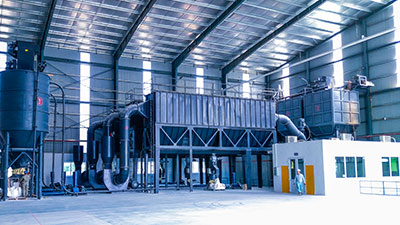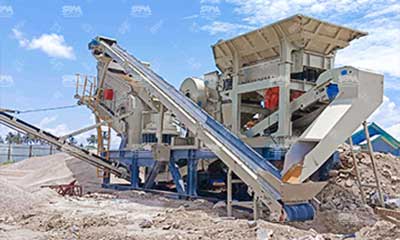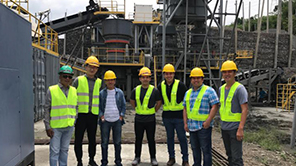Summary:In this article, we will discuss the eight most common types of gold ore and their properties, as well as the ways to process them
Gold ore is a type of ore that contains gold mineralization in its composition. It is a valuable and sought-after metal due to its rarity and beauty, as well as its industrial and economic applications. The gold content in ore varies widely, from a few grams to several ounces per ton. Different types of gold ore have different physical and chemical properties, which affect the mining, processing, and refining methods used to extract the gold.
In this article, we will discuss the eight most common types of gold ore and their properties, as well as the ways to process them.

7 Types of Gold Ore
1. Free-milling Gold Ore
Free-milling gold ore is the most common type of gold ore, which is often found in open-pit mines. It is characterized by the presence of visible gold particles that are easily liberated from the surrounding rock by crushing and grinding. The gold particles are usually small, ranging in size from a few microns to a few millimeters.
The processing of free-milling gold ore involves crushing the ore to a fine powder, which is then mixed with water to form a slurry. The slurry is then passed over a series of gravity separation devices, such as sluices, jigs, or shaking tables, which concentrate the gold particles by exploiting their different densities. The resulting concentrate is then smelted to produce gold bullion.
2. Iron Oxide-copper-gold Ore
Iron oxide-copper-gold ore is a type of ore that is often associated with large-scale, low-grade deposits. It is characterized by the presence of iron oxide minerals, such as magnetite or hematite, as well as copper and gold minerals. It is often found in iron oxide-copper-gold (IOCG) deposits, which are associated with intrusive rocks.
The processing of iron oxide-copper-gold ore involves crushing the ore to a fine powder, which is then mixed with water to form a slurry. The slurry is then subjected to magnetic separation, which separates the iron oxide minerals from the copper and gold minerals. The resulting concentrate is then subjected to flotation, which separates the copper and gold minerals from the other minerals in the ore. The resulting concentrate is then smelted to produce copper and gold bullion.
3. Refractory gold ore
Refractory gold ore is a type of ore that contains gold that is difficult to extract using conventional methods. It is often associated with sulfide minerals, such as pyrite, arsenopyrite, or stibnite, which can encapsulate the gold particles and prevent them from being liberated by conventional crushing and grinding methods.
The processing of refractory gold ore involves a combination of physical and chemical methods. First, the ore is subjected to pre-treatment, which involves roasting, pressure oxidation, or bio-oxidation to break down the sulfide minerals and liberate the gold particles. The resulting ore is then subjected to conventional cyanide leaching or alternative methods, such as thiosulfate leaching, which can dissolve the gold particles and make them available for recovery.
4. Carbonaceous gold ore
Carbonaceous gold ore is a type of ore that contains organic carbon, such as graphite or bituminous materials, that can adsorb gold particles and make them difficult to recover by conventional methods. It is often associated with sedimentary rocks or coal seams.
The processing of carbonaceous gold ore involves pre-treatment to remove the organic carbon by roasting or autoclaving, followed by cyanide leaching to dissolve the gold particles. Alternatively, alternative lixiviants, such as thiosulfate, iodine, or bromine, can be used to dissolve the gold particles.
5. Orogenic gold ore
Orogenic gold ore is a type of gold ore that is formed by the deformation and metamorphism of pre-existing rocks, such as sedimentary rocks or volcanic rocks. It is often associated with quartz veins or shear zones.
The processing of orogenic gold ore involves crushing the ore to a fine powder, which is then mixed with water to form a slurry. The slurry is then passed over a series of gravity separation devices, such as sluices, jigs, or shaking tables, which concentrate the gold particles by exploiting their different densities. The resulting concentrate is then smelted to produce gold bullion.
6. Epithermal gold ore
Epithermal gold ore is a type of gold ore that is formed near the surface of the Earth by the action of hot fluids. It is often associated with volcanic rocks or geothermal systems.
The processing of epithermal gold ore involves crushing the ore to a fine powder, which is then mixed with water to form a slurry. The slurry is then subjected to gravity separation or flotation to concentrate the gold particles. The resulting concentrate is then smelted to produce gold bullion.
7. Porphyry gold-copper ore
Porphyry gold-copper ore is a type of ore that is often associated with large-scale, low-grade deposits. It is characterized by the presence of copper minerals, such as chalcopyrite, bornite, or chalcocite, as well as gold minerals, such as pyrite or native gold. It is often found in porphyry copper deposits, which are associated with intrusive rocks.
The processing of porphyry gold-copper ore involves crushing the ore to a fine powder, which is then mixed with water to form a slurry. The slurry is then subjected to froth flotation, which separates the copper and gold minerals from the other minerals in the ore. The resulting concentrate is then smelted to produce copper and gold bullion.
8 Gold Extraction Methods You Need to Know
Extraction methods for gold ores depend on the type of ore, its grade, and other factors such as the presence of other minerals and impurities. Here are some of the most common extraction methods used for gold ores:
1. Gravity separation
This method is used for free-milling gold ores and involves using gravity to separate gold from other minerals. The ore is crushed and then passed over a series of riffles, which trap the gold particles while allowing the other minerals to pass through.
2. Cyanide leaching
This method is used for gold ores that are amenable to cyanide leaching, such as free-milling and some refractory ores. The ore is crushed and then mixed with a cyanide solution, which dissolves the gold. The gold is then recovered from the solution by adsorption onto activated carbon or by precipitation with zinc dust.
3. Amalgamation
This method is used for free-milling gold ores and involves mixing the crushed ore with mercury to form an amalgam. The gold is then recovered by heating the amalgam to vaporize the mercury.
4. Flotation
This method is used for sulfide ores, such as porphyry gold-copper and iron oxide-copper-gold ores. The ore is crushed and then ground to a fine powder, which is then mixed with water and frothing agents. Air is bubbled through the mixture, causing the sulfide minerals to float to the surface, where they can be collected and separated from the other minerals.
5. Roasting
This method is used for refractory gold ores and involves heating the ore to high temperatures to oxidize the sulfide minerals and release the gold. The resulting calcine is then subjected to cyanide leaching to extract the gold.
6. Pressure oxidation
This method is used for refractory gold ores and involves subjecting the ore to high pressures and temperatures in the presence of oxygen and sulfuric acid. This process oxidizes the sulfide minerals and makes the gold amenable to cyanide leaching.
7. Bioleaching
This method is used for refractory gold ores and involves using microorganisms to oxidize the sulfide minerals and release the gold. The microorganisms are cultured in tanks containing the ore and a nutrient solution, and the resulting solution is then subjected to cyanide leaching to extract the gold.
8. Carbon-in-pulp (CIP)
This method is used for Carlin-type gold ores and involves mixing the crushed ore with a cyanide solution and activated carbon. The gold is then adsorbed onto the activated carbon, which is separated from the ore and then subjected to elution to recover the gold.
In conclusion, gold extraction from different types of gold ores requires different methods due to their varied mineralogy and grade. Understanding the properties of different types of gold ores and their processing methods is important for the mining industry. By using the appropriate processing methods, miners can extract gold efficiently and sustainably, while minimizing environmental impact and ensuring the safety of workers.



























